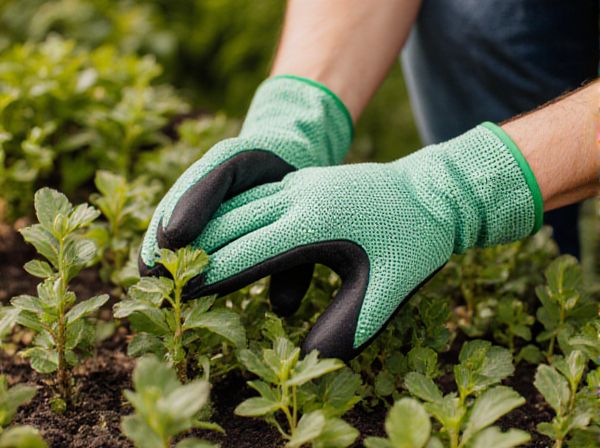
Dwarf varieties vs Full-size varieties Illustration
Dwarf container varieties are ideal for limited spaces, offering compact growth without sacrificing aesthetic appeal or yield. Full-size varieties require larger containers and more root space, but they often produce higher yields and more robust plants. Choosing between dwarf and full-size varieties depends on available space, container size, and desired productivity.
Table of Comparison
| Feature | Dwarf Varieties | Full-Size Varieties |
|---|---|---|
| Plant Size | Compact, 2-4 feet | Large, 6-12 feet |
| Growth Rate | Faster, ideal for containers | Slower, requires more space |
| Space Requirement | Minimal, fits small containers | Extensive, needs large containers or garden |
| Yield | Moderate, suitable for limited space | High, best for maximum production |
| Maintenance | Lower, easier pruning and care | Higher, requires more pruning and support |
| Root System | Shallow, adapts well to containers | Deep, needs ample soil volume |
| Ideal Use | Balconies, patios, small spaces | Open gardens, large yards |
Introduction to Dwarf and Full-Size Plant Varieties
Dwarf plant varieties offer compact growth habits ideal for container gardening, requiring less space and making maintenance easier compared to full-size varieties. Full-size plants typically produce larger yields and have more extensive root systems, necessitating bigger containers and more resources for optimal growth. Choosing between dwarf and full-size varieties depends on available space, desired plant size, and specific garden goals.
Key Differences Between Dwarf and Full-Size Plants
Dwarf varieties are genetically compact, making them ideal for container gardening due to their smaller root systems and limited height, which conserves space and facilitates easier maintenance. Full-size varieties possess extensive root systems and taller growth, requiring larger containers and more soil volume to support their development and nutrient needs. The key differences include growth habit, root system size, and container adaptability, directly influencing water requirements and overall plant management.
Benefits of Choosing Dwarf Varieties for Containers
Dwarf varieties are ideal for container gardening due to their compact size, which allows for efficient use of limited space and easier management. These varieties typically require less water and nutrients, reducing maintenance and resource consumption in containers. Their controlled growth habit also minimizes the risk of root overcrowding, promoting healthier development and higher yields in confined environments.
Advantages of Full-Size Varieties in Gardening
Full-size container plants offer deeper root systems that enhance nutrient absorption and overall plant health, leading to more vigorous growth compared to dwarf varieties. They tend to produce higher yields, making them ideal for gardeners aiming for abundant harvests or large floral displays. Larger varieties also contribute to improved resilience against pests and environmental stress, promoting long-term garden sustainability.
Space Efficiency: Dwarf vs Full-Size in Small Gardens
Dwarf container plants maximize space efficiency in small gardens due to their compact root systems and slower growth, allowing multiple varieties to thrive in limited areas. Full-size varieties require larger containers and more spacing, often making them unsuitable for tight spaces and reducing overall planting density. Choosing dwarf varieties enhances plant diversity and yield per square foot in constrained garden environments.
Yield Comparison: Dwarf Versus Full-Size Plants
Dwarf container plants consistently produce higher yields per square foot compared to full-size varieties due to their compact growth habit and efficient resource use. Full-size container plants often generate greater total yield per individual plant but require significantly larger pots and space, reducing overall productivity in limited-area settings. Yield efficiency in dwarf varieties makes them ideal for urban gardening and small-scale container cultivation where maximizing output in minimal space is crucial.
Care and Maintenance Requirements
Dwarf container plants require less frequent watering and pruning compared to full-size varieties, making them ideal for limited space and low-maintenance gardening. Full-size container plants often need larger pots, more soil nutrients, and consistent trimming to maintain shape and health. Both varieties benefit from regular monitoring for pests and diseases, but dwarf types generally adapt better to container conditions due to their reduced root systems and slower growth rates.
Ideal Crops for Dwarf and Full-Size Container Gardening
Dwarf varieties such as patio tomatoes, mini bell peppers, and compact herbs like basil thrive in containers due to their smaller root systems and space requirements. Full-size varieties, including standard tomato plants, large pepper cultivars, and sprawling squash, demand larger containers with deeper soil to support extensive root development and nutrient uptake. Selecting crops based on growth habit and container size maximizes yield and ensures healthy plant growth in confined gardening spaces.
Aesthetic Appeal: Visual Impact in Garden Design
Dwarf container varieties offer compact growth and dense foliage, creating a neat and structured visual impact ideal for small garden spaces and patios. Full-size container varieties provide dramatic height and presence, contributing bold focal points and dynamic vertical lines within garden design. Choosing between dwarf and full-size varieties depends on the desired garden scale and the role of the container as a subtle accent or a commanding centerpiece.
Choosing the Best Variety for Your Container Garden
Dwarf varieties are ideal for container gardening due to their compact size, manageable root systems, and ability to thrive in limited space, making maintenance easier and maximizing growth potential. Full-size varieties often require larger containers and more care to prevent overcrowding and nutrient depletion, posing challenges for container environments. Selecting dwarf varieties optimizes space utilization, encourages healthier plants, and reduces the need for frequent repotting, ensuring a successful and sustainable container garden.
Dwarf varieties vs Full-size varieties Infographic

 gardendif.com
gardendif.com